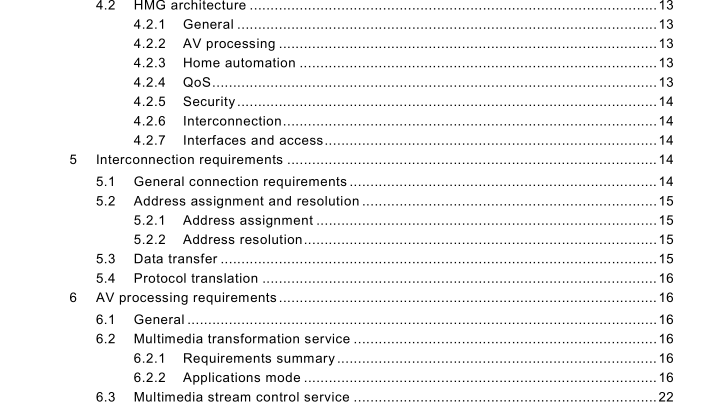IEC 62514:2010 pdf download – Multimedia gateway in home networks – Guidelines
4.2.5security
The HMG shall support DRM,key management, authentication and security to log on outsidenetworks.
4.2.6lnterconnection
HMG shall support the network management,protocol translation,address assignment,configuration and management on the home networked devices,in different multimedianetworks.
4.2.7 lnterfaces and access
These provide the connection between the home network and outside networks (for example thelnternet) when necessary, which is optional.
The detailed interface and communication protocol requirements on both LAN side and WANside are specified in Clause 11.The specific protocol that is to be applied depends on theapplication case.
5 lnterconnection requirements5.1General connection requirements
Where the home multimedia network is an lP network, the requirements for the HMG should beas follows:
a) HMG shall implement a Dynamic Host Configuration Protocol (DHCP) server in order toassign lP address to DHCP client in the home network where the HMG is involved.
b) HMG should support Domain Name System (DNS) in order to use device name for betteruser experience.
c) Those messages are formatted by using the SOAP HTTP binding, which shall be compliantwith ISO/IEC 29341-1.
d) HMG should collect information with respect to all the devices connected to the homenetwork by using device description and service description of each device in order tomanage the devices.
e) HMG also should control other devices such as HMRec and HMSou by using appropriate
actions to realize use cases described in this standard.
HMG shall also conform to the following requirements defined and specified in lEC 62481-1.
f) HMG shall support a TCP/IP stack that includes lPv4,TCP, UDP,ARP, and lCMP.
g) HMG may also support general capability recommendations and device recommendations.
h) The detailed methods of interconnection shall be compliant with 7.3 of lEC 62481-1:2007(Device discovery and control).
i) HMG shall support Simple Object Access Protocol (SOAP) header and body elements, andthe messages are delivered via HTTP.The HMG as well as HMSou and HMRec support themessaging scheme by using GENA protocol to exchange the event information inside thehigh-speed system. A control point invokes the action to the device’s service in order tocontrol it and when the action has completed or failed, the service returns any results orerrors of the action.
j)HMG shall support the detailed methods of device management.
5.2Address assignment and resolution5.2.1Address assignment
The HMG shall support the functions of address assignment as follows:
a) HMG shall assign the identifiers to each control sub-network in order to identify different
sub-networks.
b) The control sub-network gateway shall apply for the addresses,which comply for the
higher-level network protocol and are composed of sub-network identifier and networkaddress,from the HMG.
c) The HMG shall have the following address assignment functions.
1) The HMG shall support DHCP server to assign the addresses for the devices managed in the home network.Through a management and configuration interface on the HMG, theDHCP can be enabled or disabled, and the data such as address pool assignment on theDHCP can be configured as well.
2) The terminal devices shall also support AutolP in case there is no DHCP server in the sub-network.
5.2.2Address resolution
The HMG shall support the functions and requirements of address resolution as follows:
a) lf the source devices and destination devices are located in the same control sub-network or multimedia network,then the HMG shall forward the data packet directly without anyprocessing.
b) lf the source devices and the destination devices are not located in the same control sub-network or multimedia network, then
1) The source devices shall know the identifier and network address of the control sub-network or multimedia network in which the destination devices are located.
2) The HMG shall resolve the data packet sent from the source devices and identify the identifiers and network addresses of the control sub-network or multimedia network inwhich the source devices and destination devices are located respectively.
3) The HMG shall confirm the network and address of the destination devices located according to the identifier and network address of that control sub-network or multimedianetwork.
4) The HMG shall confirm the communication protocol of the destination devices from the device registry.
5) The HMG shall then re-pack the data and send to the destination device in accordance with the communication protocol confirmed.
c) The HMG shall support the ARP protocol as well.
